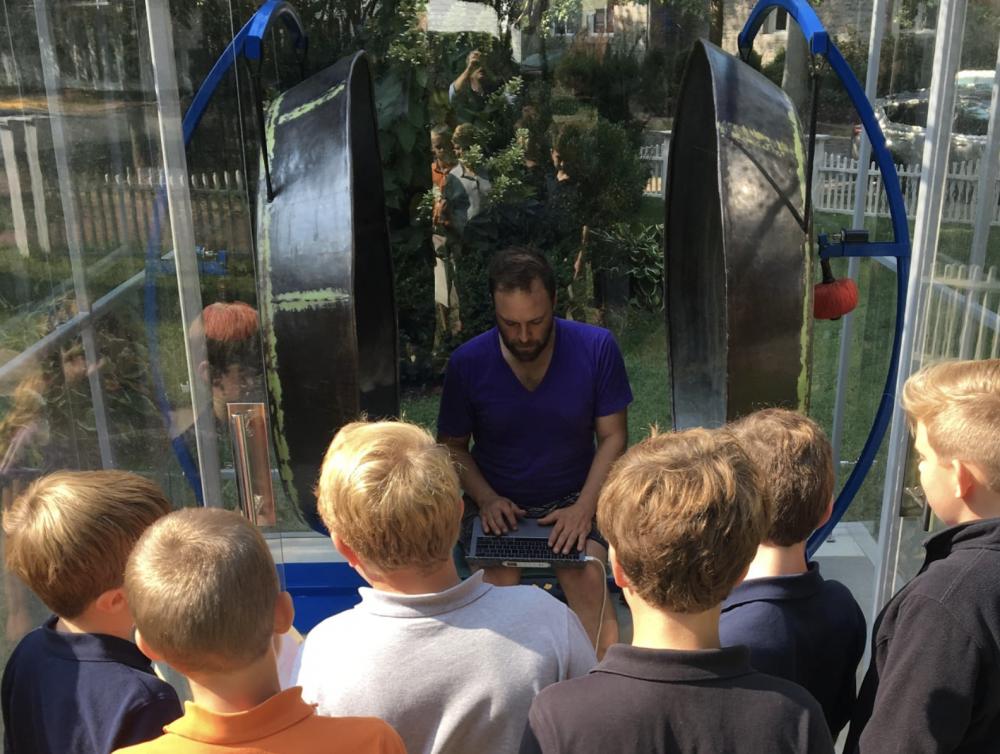We think of sound, of course, as a hearing experience received through our ears and processed in our brain to identify the source and interpret what that noise is all about. What it all means, if anything. But the science behind aural sensations and the anatomy of hearing reveals the physicality of sound itself and of our ability, or inability, to be cognizant of its manifestation.
 We use headphones to isolate sounds when we want to pay particular attention to them, listening to music or speech—whether a country or classical recording, a lecture we might have missed in person or a book being read to us by an actor. But in “Bodyphones,” a sonic and kinetic sculptural installation on the lawn outside Easton’s Academy Art Museum, conceptual artist Aaron Tyler Kuffner endeavors to teach us how to “hear” with our whole bodies. (We have plenty of time to learn as the installation remains in place through May 31, 2020.)
We use headphones to isolate sounds when we want to pay particular attention to them, listening to music or speech—whether a country or classical recording, a lecture we might have missed in person or a book being read to us by an actor. But in “Bodyphones,” a sonic and kinetic sculptural installation on the lawn outside Easton’s Academy Art Museum, conceptual artist Aaron Tyler Kuffner endeavors to teach us how to “hear” with our whole bodies. (We have plenty of time to learn as the installation remains in place through May 31, 2020.)
“It’s an orchestra of two percussion instruments,” Kuffner says, created out of his five-year studies of gamelans in Indonesia. Traditional gamelans are percussive metallophones played by banging the iron-and-brass instruments with a mallet accompanied by a set of hand-thumped drums. By adding an electronic component Kuffner, who considers himself a sculptor and a musician as well as a composer with “tech inclinations,” created what he calls a Gamelatron, which allows him to “exercise diverse artistic muscles.”
Now based in Brooklyn, Kuffner collaborated with Eric Singer, an engineer and musician, to build a prototype of a robotized musical instrument, which has since “evolved more into a sculpture breaking the boundary between performer and listener,” as Kuffner describes it.
OK, I get the sculpture part. The installation looks a bit like a museum artifact of TV’s 1970s game series, “The Gong Show.” Only it’s played not for laughs but with gongs positioned on either side of the listener seated inside a glass enclosure looking out toward the Waterfowl Festival building across South Street from the Academy museum. From behind, Christ Church is out of sight but not necessarily out of hearing, across Harrison Street, as its steeple bells go off every quarter hour.
Playing the “Bodyphones” Gamelatron is simple and intuitive if you adhere to instructions to press, one at a time, five gold-colored buttons situated in front and just below the installation’s cushioned seat. You may or may not recognize the sonic waves that come your way as music. To me, they sound more like a meditative “ohhhmmm” some of us may have practiced transcendentally in the 1960s and ’70s, except that it’s electronic rather than vocal. The sounds are mostly deep bass caused by cloth-covered mallets resembling miniature Halloween pumpkins clanging against brass nipples on the outer center of the iron gongs that open on opposite sides like giant mushroom caps aimed at the head and upper body of a seated audience of one. On some of the five variations, a hum one or two notes higher than the low-pitched resonant gong resembles a symphonic monotone in rising or pulsing wavelengths.
Perhaps that’s the point—experiencing sound as physical waves, which is what makes it possible for them to burst through barriers at a certain shattering speed. As there are no prohibitions against “touching” the sound, I reached out to feel the range of vibrations with each gong and each hum. It’s sort of like hearing in braille, you might say. But I doubt it will sell on Spotify.
Steve Parks is a retired journalist, arts writer, critic and editor now living in Easton.
“Gamelatron @ AAM: ‘Bodyphones’ ”
Through May 31, 2020, Academy of Art Museum, 106 South St., Easton
INFO: 410-822-2787, academyartmuseum.org



Write a Letter to the Editor on this Article
We encourage readers to offer their point of view on this article by submitting the following form. Editing is sometimes necessary and is done at the discretion of the editorial staff.